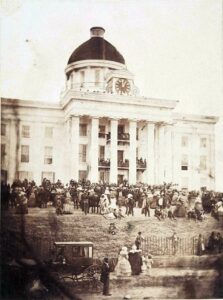The 42 delegates, at the Confederate Constitutional Convention, unanimously propose the Constitution for the Confederate States to the seven seceded States for ratification. The convention spent most of its time addressing what it felt were the misconstructions of the Constitution for the united States:
- The word “person” is replaced with the word “slave” (Constitution of the Confederate States, Article I, Section 2 [Clause 3; Article I, Section 9 [Clauses 1, 2 and 4; Article IV, Section 3 [Clause 3];
- The international slave trade between the Confederate States and the united States is permitted (CftCS, Article I, Section 9 [Clauses 1 and 2];
- Congress may not prohibit slavery (CftCS, Article IV, Section 2 [Clause 1];
- State legislatures may impeach Confederate officials assigned to their States (CftCS, Article I Section 2 [Clause 5];
- Cabinet secretaries are non-voting members of Congress (CftCS, Article I Section 6 [Clause 2];
- A line-item veto for the President is clarified (CftCS, Article I Section 7 [Clause 2];
- The phrase “general Welfare” is dropped from (CftCS, Article I Section 8 [Clause 1), furthermore (protective) tariffs designed to benefit domestic industries are prohibited ;
- Subsidizing industry is specifically prohibited (CftCS, Article I Section 8 [Clause 3];
- The Post Office must not be subsidized by taxes but operate on its own revenues (CftCS, Article I, Section 8 [Clause 7];
- Three new clauses require a two-thirds vote to spend money, monies to be spent must be exactly stated in the bill, cost overruns by contractors are prohibited, and spending bills must be confined to but one subject expressed in its title (CftCS, Article I, Section 9 [Clauses 9, 10 and 20];
- Articles I through VIII of Amendment from the Constitution for the united States are incorporated in the CftCS, Article I, Section 9 [Clauses 11 through 19;
- The President and Vice President are both elected to a single six-year term, and ineligible for re-election (CftCS, Article II, Section 1 [Clause 1];
- Article XII of Amendment from the CftuS is incorporated in the CftCS, Article II, Section 1 [Clauses 3 through 5];
- Article XI of Amendment from the CftuS is incorporated in the CftCS, Article III, Section 2 [Clause 1];
- New States are admitted to the Confederacy only with a two-thirds vote of both houses of Congress (CftCS, Article IV, Section 3 [Clause 1];
- Congress may not propose amendments to the Constitution, rather amendments are proposed by any three State legislatures and approved by two-thirds of the States – not three-fourths (CftCS, Article V];
- Articles IX and X of Amendment from the CftuS are incorporated in the CftCS, Article VI, Sections 5 and 6;
- The Constitution, once ratified, will take effect on the February 22nd (Washington’s Birthday) immediately following.
[updated 1/25/2025]
Subsequent Events:
Authority:
unanimous Declaration (of Independence), Paragraph 6
ccc-2point0.com/unanimous-declaration-of-independence
Provisional Constitution for the Confederate States, Preamble
avalon.law.yale.edu/19th_century/csa_csapro.asp
References:
Bruce Catton, The Civil War, (New York: American Heritage, 1960; Boston: Houghton-Mifflin, 1987), 283.
Thomas J. DiLorenzo, “The Great Centralizer: Abraham Lincoln and the War of Federal Aggression,” Cato Journal, 3 (Fall 1998): 259.
Calvin D. Linton, ed. The Bicentennial Almanac: 200 Years of America, 1776-1976, (Nashville, Tennessee: Thomas Nelson, 1975), 164.
CONSTITUTION OF THE CONFEDERATE STATES
avalon.law.yale.edu/19th_century/csa_csa.asp
Avalon Project – Constitution of the Confederate States; March 11, 1861
avalon.law.yale.edu/19th_century/csa_csa.asp
Confederate States Constitution – Wikipedia
en.wikipedia.org/wiki/Confederate_States_Constitution#Contemporary_reception


